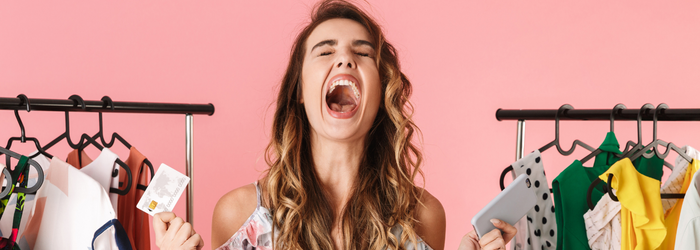How to Solve Wardrobe Panic
By curating our wardrobes with second-hand clothing, considering fibre content at purchase, and keeping our clothes for longer, we can solve the enduring dilemma of ‘I have nothing to wear’, while also considering our planet.

Have you experienced ‘wardrobe panic’? The feeling of opening your wardrobe to find that you have so many clothes but nothing to wear. You’re not alone, it’s a familiar state for many of us.
The good news is that wardrobe panic is curable in a simple way that rids us of outfit exhaustion without sacrificing our environment. Say hello to the second-hand capsule wardrobe and goodbye to decision fatigue, with the added benefit of feeling good about the clothes you wear.
A second-hand capsule wardrobe is a collection of pre-owned clothes, bought from opportunity shops or clothing resale platforms, consisting of items that transcend occasions, trends and seasons. Featuring neutral colours like black, white, brown, and beige, or a more modern neutrals palette including russet reds and deep olive greens, a second-hand capsule wardrobe aims for a limited (and more manageable) amount of clothes that can be turned into potentially infinite outfits, with less impact on the environment.
How to build a second-hand capsule wardrobe
Before you make the trip to your local Vinnies for pre-owned clothing finds, channel your inner Marie Kondo and take stock of your current collection of clothes to see what is and isn’t useful in your daily life and which pieces do or do not, in the words of Marie,
“spark joy”.
A second-hand capsule wardrobe should be a carefully considered curation of clothing, edited down to interchangeable pieces that can combine to create many different outfits. Consider elements like colour palette, outfits for the office, the social events you usually attend and even leisurewear for around the house and the activewear crammed in the darkest depths of your closet.
Edit your current wardrobe to assess what you do and don’t regularly need, and which items suit your personal style (including the clothes with tags still attached!). Either donate your culled clothes or drop them off at a textiles recycling service for an added boost of environmental benefit.
Great places to begin building your second-hand capsule wardrobe are the racks of donated clothes at your local second-hand shop, or even online resale platforms such as Facebook Marketplace and Depop. Look out for plain coloured t-shirts, tank tops, blouses, and shirts, as well as knitwear, blazers, tailored pants, dresses, and skirts. Maybe even a coat or two.
Fibre content and the environment
Before you launch into combing the racks for your next second-hand shopping treasure, there is an important thought to keep in mind: always consider fibre content and its impact on the environment.
Fibre content means the individual yarns and tiny fibres that make up the fabrics of your clothes, and the percentage or amount of each of these fibres that make up a garment. These fibres can be natural, like wool or cotton, or man-made fibres, like nylon or polyester.
When shopping for clothing to add to your second-hand capsule wardrobe, make sure to check what fibres the garment is made from by looking at the fibre content tag on the inside of the clothes, which usually sits alongside care labels or washing instructions. If you’re purchasing through online resale, ask the seller to send you a picture of the fibre content label instead. This is important because our fibre choice at purchase – even of second-hand clothing – can still impact our environment, especially when we wash our clothes.
When washed, clothes made from man-made materials or synthetic fabrics can release microplastics, which are tiny plastic particles. Washing textiles made of synthetic materials is a source of microplastic pollution in the environment, with over 14 million tonnes of microplastics having accumulated on the world’s ocean floor. Microplastic pollution is increasing every year and causing harm to ecosystems, animals, and even the human food chain. Even though this shedding of microplastics decreases over many washes, as our clothes wear out and break down with age, older clothing can see an increase in microplastic shedding as the fabric deteriorates.
A helpful solution is to check the fibre content label on clothing for alternatives to synthetic fabrics which include natural fibres, such as wool and cotton. Fibres like wool, for instance, are made of natural elements, meaning that the fibre does not accumulate in the environment and does not contribute to microplastic pollution.
The ‘30 Wear Rule’
Another consideration when hunting for clothing to build a second-hand capsule wardrobe is the ‘30 Wear Rule’. To simply solve the problem of ‘having nothing to wear’, the rule asks us to consider: ‘will I wear this item thirty times?’ If not, that item doesn’t get a spot in our wardrobes!
Encouraging us to slow down our consumption and discarding of fashion – and the amount of textile waste we produce – the 30 Wear Rule helps us to consciously engage with slow fashion, to keep and wear our items for longer, and to decrease our purchase of clothes that we can realistically go without.
A great benefit of the limited space that second-hand capsule wardrobes require is that each item can be easily assessed by using the 30 Wear Rule. By asking ourselves if an item of clothing adds value to our lives beyond just a few wears, we can make the most of our much-loved wardrobe space while deeply thinking about how the clothes we buy impact our planet.
Solving ‘wardrobe panic’ by creating a second-hand capsule wardrobe is a conscious shift to think about the clothes we wear while being mindful of our impact on the environment. Enjoy the process of exploring your personal tastes and lifestyle, by discovering clothing with long-lasting value that doesn’t cost the earth.
Want to learn more about how to make a positive impact on the environment while still finding clothes that you’ll love to wear? Find out more here.
Rachel Gallagher is a fashion writer based in Australia.
Search for other blog topics:


